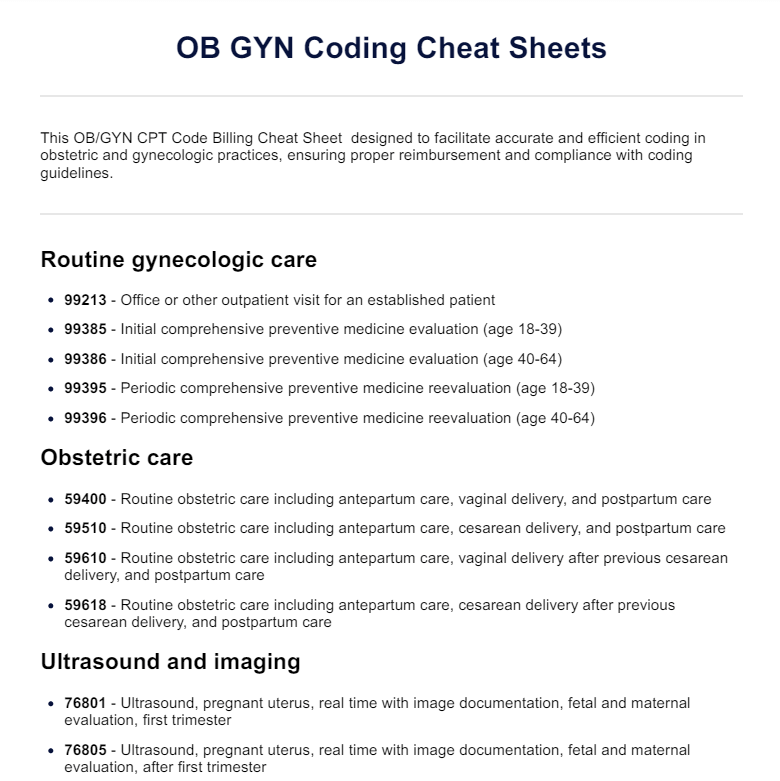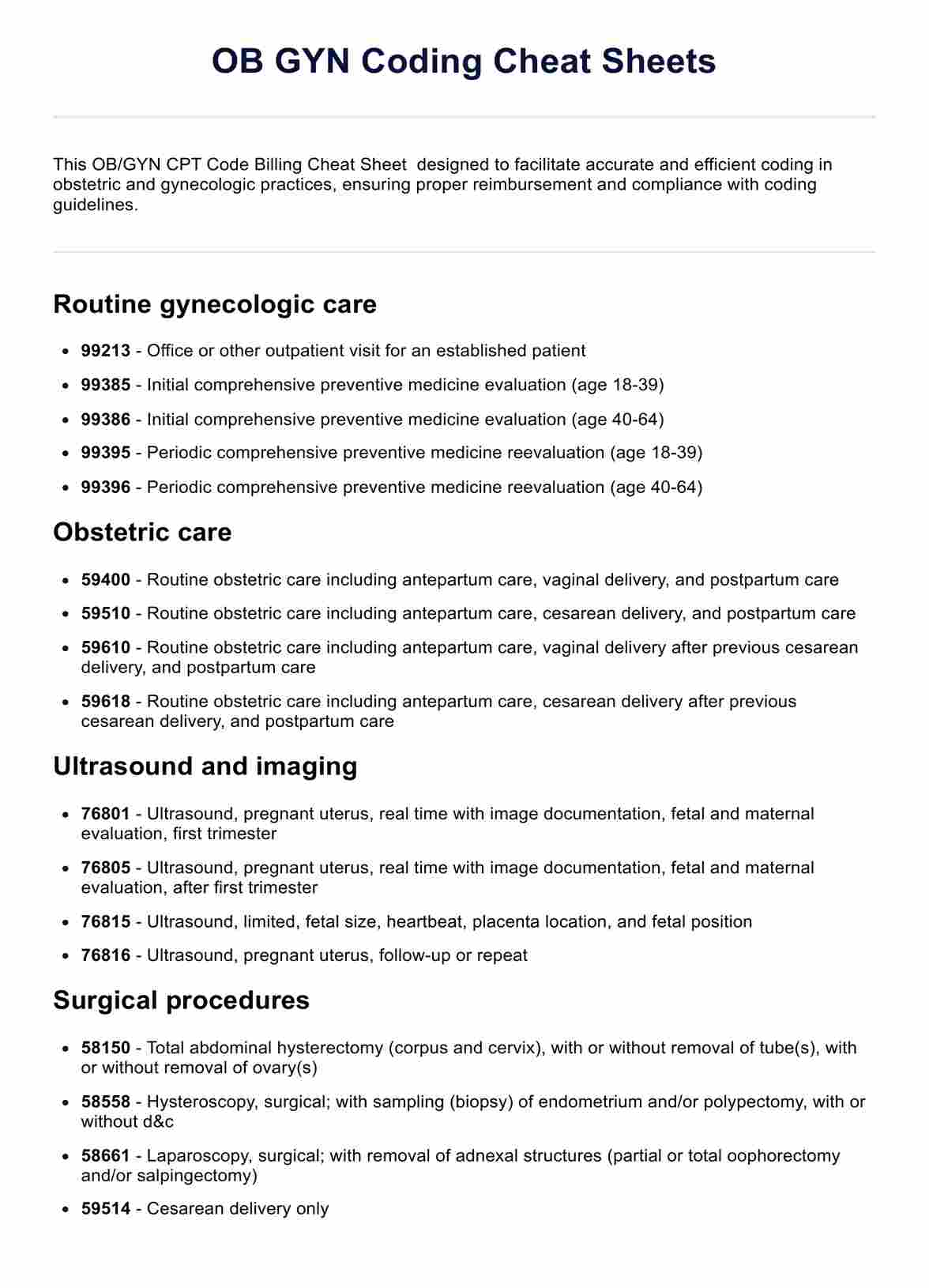OB GYN Coding Cheat Sheets PDF
Download Carepatron's free PDF guide with OB GYN coding cheat sheets and examples to help you accurately code for obstetrics and gynecology procedures.


What are CPT codes?
Current Procedural Terminology codes or CPT codes are essential tools in the medical billing process. Developed by the American Medical Association (AMA), CPT codes standardize the language used to describe medical, surgical, and diagnostic services for maternity care.
This system ensures accurate patient coding, which is crucial for providers to submit claims and receive appropriate service reimbursement. In the context of OBGYNE coding, CPT codes cover a wide range of steps, from routine gynecologic care to more complex surgeries.
For instance, a global code might be used for a procedure that includes all necessary services within a specified period, such as a complete hysterectomy. At the same time, separate evaluations might be billed for additional services outside of this period.
Accurate CPT coding is vital for enhancing the patient experience. It helps minimize medical billing and OB contract errors and streamline reimbursement. Global codes simplify medical billing for comprehensive treatments, whereas individual codes ensure that all aspects of care, including any separate evaluations, are accounted for.
OB GYN Coding Cheat Sheets PDF Template
OB GYN Coding Cheat Sheets PDF Example
Common OB GYN CPT codes
Proper coding is essential for efficient medical billing and ensuring providers submit claims correctly. Below are some of the most common OB/GYN CPT code, which play a vital role in the medical billing process and affect the patient experience by streamlining care and reimbursements.
99213 – Office or other outpatient visit
CPT code 99213 is used for an established patient office or other outpatient visit, requiring a medically appropriate history and/or examination and a low level of medical decision-making. This code is crucial in gynecology coding for routine gynecologic care, including follow-up visits, maternity care, and management of chronic conditions.
59510 – Routine obstetric care including cesarean delivery
The global code 59510 covers routine obstetric care, including antepartum care, cesarean delivery, and postpartum care. This international code simplifies the billing process by bundling services commonly provided together, ensuring comprehensive and accurate coding for obstetric care.
58150 – Total abdominal hysterectomy
CPT code 58150 is used for a total abdominal hysterectomy, including the removal of the uterus and cervix. This procedure often requires other services, and accurate coding is essential to cover the surgical procedure and any separate evaluations needed before or after surgery.
57061 – Destruction of vaginal lesion(s)
The CPT code 57061 is used for the destruction of vaginal lesions using various methods such as laser, electrosurgery, or cryosurgery. Accurate codes for this procedure ensure that healthcare professionals submit claims for the specific process, affecting the reimbursement and overall patient experience.
57454 – Colposcopy with biopsy
CPT code 57454 covers a cervix colposcopy with biopsy and endocervical curettage. This code is essential for OBGYNE coding as it involves detailed well-woman exams, OB contract, and biopsies, requiring precise coding to account for the complexity of the procedure and any additional services rendered.
Common OB GYN Code modifiers
In medical coding, modifiers are two-digit global codes appended to CPT or Healthcare Common Procedure Coding System (HCPS) Level II codes to provide additional information about the services or steps performed. HCPS codes to describe medical procedures, supplies, products and services provided to Medicare beneficiaries and individuals enrolled in private health insurance program
Understanding common modifiers is crucial for accurate billing and reimbursement in obstetrics and gynecology practices. Below are some common OB/GYN code modifiers and their significance:
Modifier -25
Modifier -25 indicates that a significant, separately identifiable evaluation and management (E/M) service was performed by the same physician on the same day as another procedure or service. In OB/GYN practices, this modifier is often used for well-woman exams or maternity care when other services or evaluations are provided beyond routine OB care.
Modifier -51
Modifier -51 indicates that multiple steps were performed during the same patient encounter. This modifier may be used in obstetrics and gynecology when multiple methods, such as separate evaluations or treatments for different conditions, are performed during a single visit.
Modifier -59
Modifier -59 indicates that a procedure or service was distinct or independent from other services performed on the same day. This modifier may be used in OB/GYN practices when separate evaluations or treatments are provided for different anatomical sites or conditions during the same encounter.
Modifier -78
Modifier -78 indicates an unplanned return to the operating room or procedure room by the same physician following an initial procedure for a related procedure during the postoperative period. This modifier may be used for postpartum complications requiring surgical intervention in obstetrics and gynecology.
Modifier -79
Modifier -79 indicates an unrelated procedure or service performed by the same physician during the postoperative period. In OB/GYN practices, this modifier may be used for unrelated surgical steps or treatments during the postpartum period following delivery.
Commonly asked questions
Accurate OB/GYN coding ensures proper reimbursement for services provided, maintains compliance with coding guidelines, and facilitates efficient claims processing.
The codes for OB/GYN include procedures such as routine prenatal care, obstetric deliveries, gynecological surgeries, and diagnostic imaging services.
Documentation provides a clear record of the services rendered, supports the medical necessity of procedures, and helps ensure accurate code assignment for billing and reimbursement purposes.







































































































